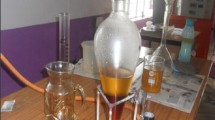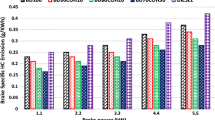Abstract
The correlation between oxides of nitrogen emission and in-cylinder temperature of diesel engine fueled with various alternative fuels has been investigated in this research paper. Experimentations were performed in engine without any modifications using pure high-speed diesel fuel, used cooking oil biodiesel (UCO20), animal fat residue biodiesel (AFR20) and camphor oil (CMR20) at 20% volume concentration of biodiesel each. From combustion analysis, the heat release rate and peak cylinder pressure of biodiesel blends were about 13.487% lower and 4.819% higher than those of diesel fuel on an average, respectively. Longer combustion duration has been observed for all biodiesel blends at all load conditions. Oxides of nitrogen emission level show 16.405, 10.352 and 7.524% increment for UCO20, AFR20 and CMR20, respectively. Noteworthy NO x reduction of about 43.8% was recorded for diesel blended with camphor oil when compared to other biodiesel blends. The relationship between in-cylinder temperature and NO x emission concentration was premeditated through thermal imager. The result depicted that the increase in NO x concentration depends on augmented in-cylinder temperature for all test fuels.







Similar content being viewed by others
References
Al H, Barsic NJ (1981) Performance and emission characteristics of a naturally aspirated diesel engine with vegetable oil fuels (part 2). SAE 1981:2925–2935. doi:10.4271/810955
Alpteki E, Canakci M, Ozsezen AN, Turkcan A, Sanli H (2015) Using waste animal fat based biodiesels–bioethanol–diesel fuel blends in a DI diesel engine. Fuel 157:245–254. doi:10.1016/j.fuel.2015.04.067
Armas O, Gomez A, Ramos A (2013) Comparative study of pollutant emissions from engine starting with animal fat biodiesel and GTL fuels. Fuel 113:560–570. doi:10.1016/j.fuel.2013.06.010
Attia Ali MA, Hassaneen AE (2016) Influence of diesel fuel blended with biodiesel produced from waste cooking oil on diesel engine performance. Fuel 167:316–328. doi:10.1016/j.fuel.2015.11.064
Awad S, Loubar K, Tazerout M (2014) Experimental investigation on the combustion, performance and pollutant emissions of biodiesel from animal fat residues on a direct injection diesel engine. Energy 69:826–836. doi:10.1016/j.energy.2014.03.078
Barrios CC, Domínguez-Saez A, Martín C, Alvarez P (2014) Effects of animal fat based biodiesel on a TDI diesel engine performance, combustion characteristics and particle number and size distribution emissions. Fuel 117:618–623. doi:10.1016/j.fuel.2013.09.037
Barsic NJ, Al H (1981) Performance and emission characteristics of a naturally aspirated diesel engine with vegetable oil fuels. SAE 1981:1173–1187. doi:10.4271/810262
Can O (2014) Combustion characteristics, performance and exhaust emissions of a diesel engine fueled with a waste cooking oil biodiesel mixture. Energy Convers Manag 87:676–686. doi:10.1016/j.enconman.2014.07.066
Cheung CS, Man XJ, Fong KW, Tsang OK (2015) Effect of waste cooking oil biodiesel on the emissions of a diesel engine. Energy Proced 66:93–96. doi:10.1016/j.egypro.2015.02.050
Fernando S, Hall C, Jha S (2006) NO x reduction from biodiesel fuels. Energy Fuels 20:376–382. doi:10.1021/ef050202m
Heywood JB (1988) International combustion engines fundamentals. McGraw Hill, New York
Hwang J, Qi D, Jung Y, Bae C (2014) Effect of injection parameters on the combustion and emission characteristics in a common-rail direct injection diesel engine fueled with waste cooking oil biodiesel. Renew Energy 63:9–17. doi:10.1016/j.renene.2013.08.051
Hwang J, Bae C, Gupta T (2016) Application of waste cooking oil (WCO) biodiesel in a compression ignition engine. Fuel 176:20–31. doi:10.1016/j.fuel.2016.02.058
Kasiraman G, Nagalingam B, Balakrishnan M (2012) Performance, emission and combustion improvements in a direct injection diesel engine using cashew nut shell oil as fuel with camphor oil blending. Energy 47:116–124. doi:10.1016/j.energy.2012.09.022
Kasiraman G, Edwin Geo V, Nagalingam B (2016) Assessment of cashew nut shell oil as an alternate fuel for CI (Compression ignition) engines. Energy 101:402–410. doi:10.1016/j.energy.2016.01.086
Man XJ, Cheung CS, Ning Z, Wei L, Huang ZH (2016) Influence of engine load and speed on regulated and unregulated emissions of a diesel engine fueled with diesel fuel blended with waste cooking oil biodiesel. Fuel 180:41–49. doi:10.1016/j.fuel.2016.04.007
Mohamed Shameer P, Ramesh K (2017) Green technology and performance consequences of an eco-friendly substance on a 4-stroke diesel engine at standard injection timing and compression ratio. J Mech Sci Technol 31(3):1497–1507. doi:10.1007/s12206-017-0249-3
Mohamed Shameer P, Ramesh K, Sakthivel R, Purnachandran R (2016) Assessment on the influence of compression ratio on the performance, emission and combustion characteristics of diesel engine fuelled with biodiesel. Asian J Res Soc Sci Humanit 6(12):344–372. doi:10.5958/2249-7315.2016.01297.1
Mohamed Shameer P, Ramesh K, Sakthivel R, Purnachandran R (2017a) Effects of fuel injection parameters on emission characteristics of diesel engines operating on various biodiesel: a review. Renew Sustain Energy Rev 67:1267–1281. doi:10.1016/j.rser.2016.09.117
Mohamed Shameer P, Ramesh K, Sakthivel R, Purnachandran R (2017b) Experimental evaluation on oxidation stability of biodiesel/diesel blends with alcohol addition by Rancimat instrument and FTIR spectroscopy. J Mech Sci Technol 31(1):455–463. doi:10.1007/s12206-016-1248-5
Mohamed Shameer P, Ramesh K, Purnachandran R, Sakthivel R (2017c) Effects of injection timing and injection pressure on biodiesel fuelled engine performance characteristics: a review. Asian J Res Social Sci Humanit 7(2):310–330. doi:10.5958/2249-7315.2017.00093.4
Nantha Gopal K, Pal A, Sharma S, Samanchi C, Sathyanarayanan K, Elango T (2014) Investigation of emissions and combustion characteristics of a CI engine fueled with waste cooking oil methyl ester and diesel blends. Alex Eng J 53:281–287. doi:10.1016/j.aej.2014.02.003
Palash SM, Masjuki HH, Kalam MA, Masum BM, Sanjid A, Abedin MJ (2013) State of the art of NO x mitigation technologies and their effect on the performance and emission characteristics of biodiesel-fueled compression ignition engines. Energy Convers Manag 76:400–420. doi:10.1016/j.enconman.2013.07.059
Sahoo PK, Das LM (2009) Combustion analysis of Jatropha, Karanja and Polanga based biodiesel as fuel in a diesel engine. Fuel 88:994–999. doi:10.1016/j.fuel.2008.11.012
Sanjid HH, Masjuki MA, Kalam SM Ashrafur, Rahman MJ, Abedin SM Palash (2013) Impact of palm, mustard, waste cooking oil and Calophyllum inophyllum biofuels on performance and emission of CI engine. Renew Sustain Energy Rev 27:664–682. doi:10.1016/j.rser.2013.07.059
Senthil Kumar M, Jaikumar M (2014) A comprehensive study on performance, emission and combustion behavior of a compression ignition engine fuelled with WCO (waste cooking oil) emulsion as fuel. J Energy Inst 87:263–271. doi:10.1016/j.joei.2014.03.001
Sher E (1998) Handbook of air pollution from internal combustion engines-pollutant formation and control. Academic, London
Varuvel EG, Mrad N, Tazerout M, Aloui F (2012) Assessment of liquid fuel (bio-oil) production from waste fish fat and utilization in diesel engine. Appl Energy 100:249–257. doi:10.1016/j.apenergy.2012.05.035
Wyatt VT, Hess MA, Dunn RO, Foglia TA, Haas MJ, Marmer WN (2005) Fuel properties and nitrogen oxide emission levels of biodiesel produced from animal fats. J Am Oil Chem Soc 82(8):585–591. doi:10.1007/s11746-005-1113-2
Zhu L, Yao Xiao CS, Cheung CG, Huang Z (2016) Combustion, gaseous and particulate emission of a diesel engine fueled with n-pentanol (C5 alcohol) blended with waste cooking oil biodiesel. Appl Therm Eng 102:73–79. doi:10.1016/j.applthermaleng.2016.03.145
Acknowledgements
The authors would like to thank all who assisted in this work.
Author information
Authors and Affiliations
Corresponding author
Additional information
Editorial responsibility: Necip Atar.
Abbreviations
- NO x
-
Oxides of nitrogen
- TI
-
Thermal imager
- AFR
-
Animal fat residue biodiesel
- UCO
-
Used cooking oil biodiesel
- CMR
-
Camphor oil
- HSD
-
Pure high-speed diesel
- AFR100
-
100% animal fat residue biodiesel
- AFR20
-
20% AFR + 80% diesel
- UCO100
-
100% used cooking oil biodiesel
- UCO20
-
20% UCO + 80% diesel
- CMR100
-
100% camphor oil
- CMR20
-
20% CMR + 80% diesel
- CAD
-
Crank angle degree
- BTDC
-
Before top dead center
- PCP
-
Peak cylinder pressure
- HRR
-
Heat release rate
- ID
-
Ignition delay
- IR
-
Infrared
- CHT
-
Cylinder head temperature
Rights and permissions
About this article
Cite this article
Mohamed Shameer, P., Ramesh, K. Study on clean technology-assisted combustion behavior and NO x emission using thermal imager for alternate fuel blends. Int. J. Environ. Sci. Technol. 14, 2759–2768 (2017). https://doi.org/10.1007/s13762-017-1353-8
Received:
Revised:
Accepted:
Published:
Issue Date:
DOI: https://doi.org/10.1007/s13762-017-1353-8




